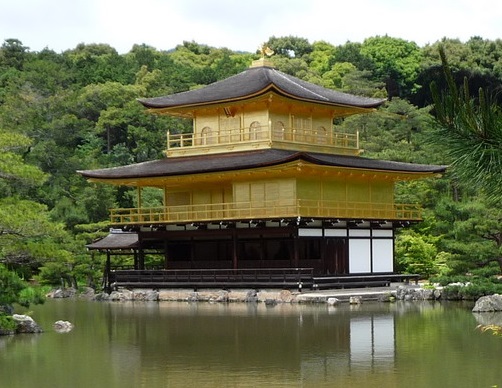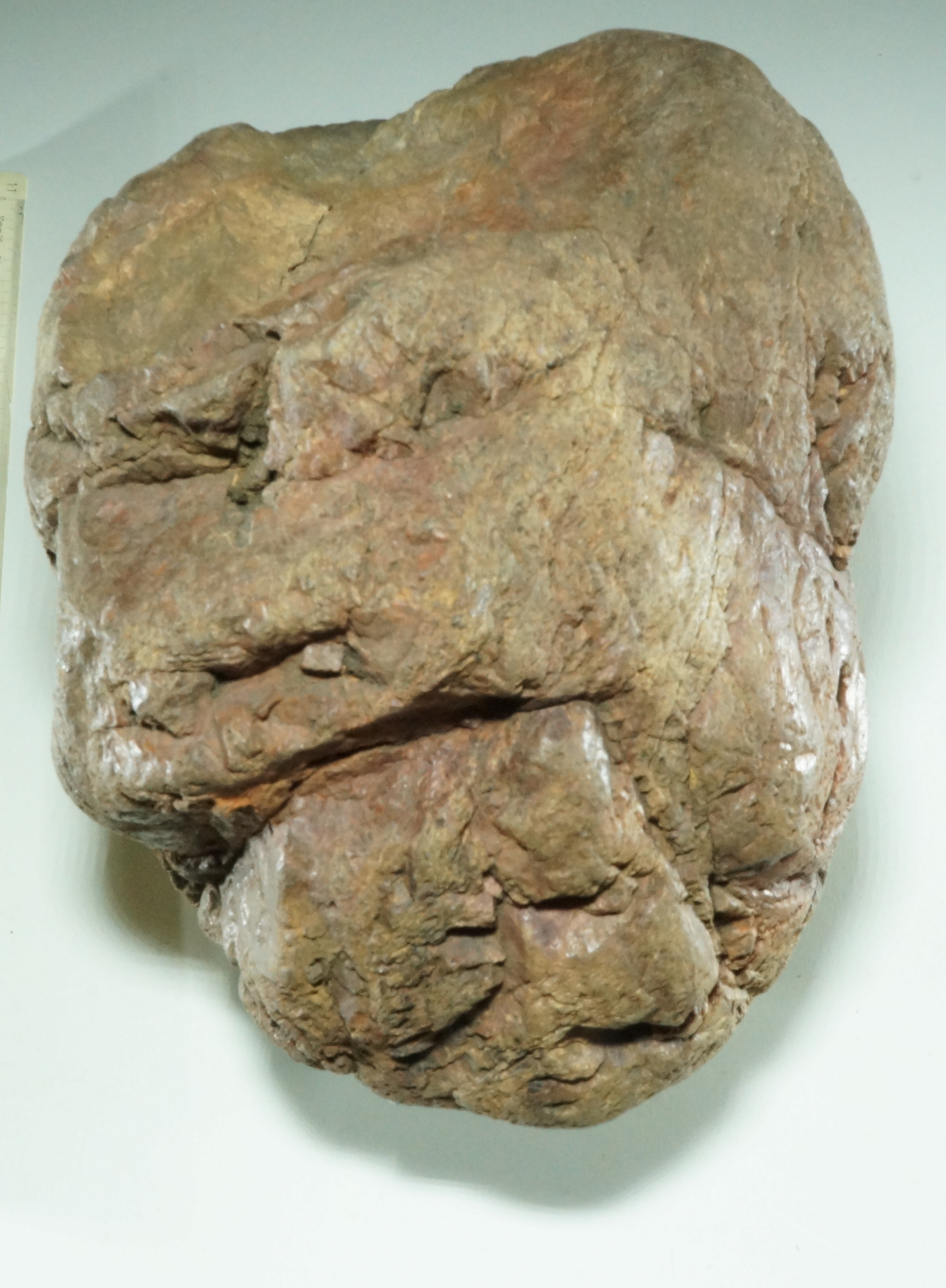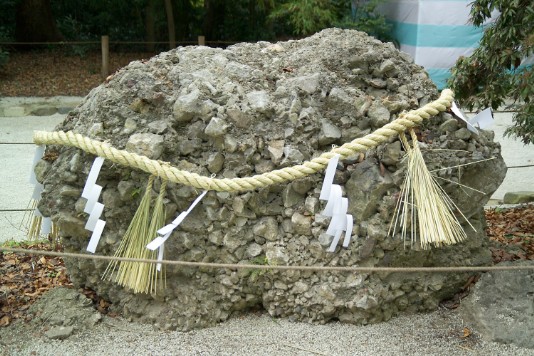.
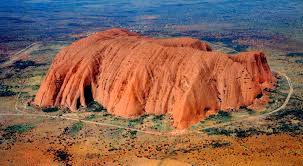
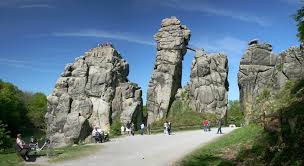

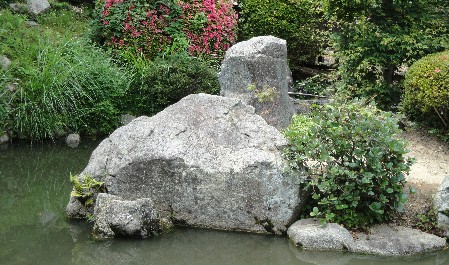
Stones
What are stones? Rocks? What is so interesting about them? Many people will think this or similar. Stones are dead (" petrified"), cold ("the heart of stone"), usually unsightly ("stone-grey"), or even obstacles ("putting up stones") and stumbling blocks.
But there are other aspects too. Some of us had a collection of stones when we were children: oddly shaped pebbles, some with faces or animal heads, some were just nice to hold ("hand-charmers") or kept alive the memory of a special place or holiday experience.
Why are large stones, often uncarved, preferred for monuments and memorials? Why are Japanese-style rock gardens so popular, even if they sometimes look like caricatures of their models? Why do strange, legendary rock formations often still seem so mysterious to us and capture our imagination? Do we think we can feel the religious shudder that gripped people thousands of years ago at the sight of these stones, making them seem sacred and divine? Such religious feelings are difficult for us to comprehend. The times in which these traditions were alive are too distant. Too great is the rupture that has occurred with the appearance of new religions and world views.
In the region near my home town we have the Externsteine (see above), a place of religious significance since time immemorial. They were given a new function by the building of a Christian chapel in the rock, while the pre-Christian tradition was "demonised" by a legend that associated the stones with the devil, who wanted to use them to build a temple and thus provoke God. Such "devil's stones" can be found in many places; for example, a large stone grave in Heiden in Westphalia is called "Düwelsteene" ("devil's stones"). Another example of Christian influence is the "Crouching Woman", a rock in the Teutoburg Forest, whose original meaning has been obscured by a Christian-influenced legend, according to which a mother saved her children on her shoulder during a great flood by asking God to turn her into a rock. Nevertheless, the mysterious and mystical magic that surrounds this rock is still palpable.
Already in the early tradition of Israel there is an example (Genesis 28:11) of how the stone cult, which was widespread in the Mediterranean region, is suppressed and replaced by the belief in the one God, Yahweh. In Canaan, where the story is set, people also worshipped certain stones as sacred, as gods, or as the dwelling place of a god, which is why they were referred to by the Aramaic word bet el ("house of God"). In the biblical narrative, the sacred cult stone becomes simply any stone that Jacob chooses for his night's rest while fleeing from Esau. Only after he has had the famous vision of the ladder to heaven, or Jacob's ladder, while sleeping with his head on it, does he consecrate the stone as a memorial stone, thus integrating the old cult into his new monotheistic faith in God. But the old tradition of the stone cult is still alive in the magic of his dream and in Jacob's religious emotion which he attributes to the place and when he then calls it Betel, i.e. House of God in the tradition of the stone cult.
The third great monotheistic religion that has shaped our modern consciousness, Islam, like Judaism, has forbidden all pictorial representations of God and, even more so, all idols. This makes it all the more surprising that it is precisely in this religion that the ancient tradition of stone cults lives on, and in a very central place, in the form of the black stone of the Kaaba in Mecca. How did this come about? How is it to be understood? No one has yet been able to give me a convincing answer. Is there perhaps something living in this tradition, something originally human, to which we no longer have conscious access? Is there perhaps more that connects us with prehistoric man than we are generally aware of?
Japanese culture may provide us with a way of approaching this. It is astonishing what an important role stones play, even for modern people in Japan, in many areas of culture, including ancient traditional forms of stone worship. In the world of the Shintō, there are countless stones that, like old trees or waterfalls, are set apart from the profane world and marked as a divine realm by the shimenawa, a thick rope of rice straw, and usually also by folded strips of paper. This religious background can still be felt where stones appear in parks or in various forms of visual art as a basic component of nature. Even the smallest medallion decorating a bowl, for example, rarely lacks a stone (often specially shaped) next to a pine or cherry branch. From this we can already see that in Japan stones are an essential part of - we must say it explicitly here - living nature. Stones are not dead, they continue to grow, albeit over almost infinite periods of time from a human point of view, of which they make people aware. Some stones play a special role in making this process of growth visible, and even have their own name: the sazare-ishi, larger stones baked together from smaller pebbles and other stones. Everyone in Japan knows them from the national anthem, where it is wished that the emperor's reign will last until the sazare-ishi has become a rock. This is a clear reference to the growth of the stone.
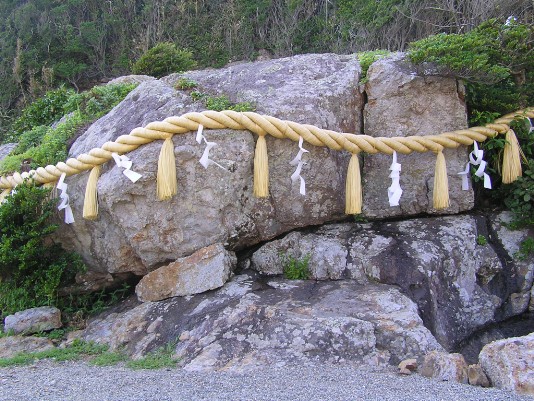
On the left, a sazare-ishi from Shimokamo Shrine in Kyoto; on the right, an advanced one from Omi Shrine in Hyuga.
Stones that resemble animals are particularly revered. They are said to have special divine powers. (Shield) Toads are particularly popular, which may have something to do with their compact body shape, which is more likely to be found in a stone. Even so, it usually takes some imagination to recognise them, as the first three examples below show. In the first example, a porcelain toad has been placed on top of the stone for unimaginative modern people (in the third, it is on the left). Stone Age people, without the flood of visual stimuli of the modern world, were probably different. It is all the more remarkable that the magical appeal of these stones is still alive in Japan today, and that the first of the "toads" below, for example, was even transported to Osaka Castle in the 16th century, where it ended up in a temple and had its own festival.
The "lion" (see below) can't be transported. It is needed on site, however, where it has protected its shrine for over 1200 years. That he is still trusted to do so is shown by the fact that the shrine does not have the usual komainu (a kind of lion) that usually stand guard in front of shrines.
Many of the stones worshipped as gods are particularly impressive because of their size, peculiar shape and the legends that have grown up around them since time immemorial, as in the case of the last two examples. [Click on the small square in the control bar to enlarge!]
1. "Lucky toad, originally in a river near Osaka Castle, then in the castle, now in a temple nearby, with its own festival.
2. "Toad in Isagawa Jinja, the oldest shrine in Nara (593)
3. "Toad, from which a tree grows at the top
4. Shishiiwa ("lion rock") in Kumano
5. Kaminari-iwa, "Rock of the Living God", at Hokura Shrine in Kobe
6. Legendary rock near the shrine on Mt. Komagatake in Hakone.
Often one finds stones that are usually referred to as inseki ("female stone") or yōseki ("male stone"). In and Yō is the Chinese Yin and Yang and as with the latter, both are seen as a unity and so are often referred to together as Inyoseki (inyōseki). An outstanding example of this can be seen below in the first picture. There, the phallus-shaped rock and the elongated one in front of it with the crevice (vulva) form a natural unity that may be unique in the world. This stands for harmony and fertility in marriage as a divine energy, which people have hoped to gain through the veneration of such stones since ancient times.
This is also true for countless small stones of similar shape that can be found all over Japan, especially along roadsides and in shrines, as in the second picture. As there, both stones are often placed close together. In the third picture, the stones in a temple have the same shapes, only more imposing because of their size, but the absence of shimenawa and folded paper strips shows that they have lost their divine charm and that now the aesthetic appeal and the artistic arrangement are in the foreground. This becomes even clearer in the next example in the same place. From the shape of the stones it is evident that they were originally typical inyoseki, but in the explanation of the temple it is about a turtle and a crane, the latter attribution being particularly surprising.
The last two examples from a park in Tokyo show that it can be done differently. Although the two stones have been placed separately and somewhat hidden, they are clearly identified as inseki and yōseki on small plaques.
In general, it is impossible to imagine Japanese parks without stones, as I try to show during a walk through parks in Tokyo.
It is common to find stones that are usually referred to as inseki ('female stone') or yōseki ('male stone'). In and Yō are the Chinese Yin and Yang and, as with the latter, the two are seen as a unity and are therefore often referred to together as inyoseki (inyōseki). An excellent example of this can be seen in the first image below. There, the phallus-shaped rock and the elongated rock in front of it with the slit (vulva) form a natural unity that may be unique in the world. It represents harmony and fertility in marriage as a divine energy that people have hoped to achieve by worshipping such stones since ancient times.
This is also true of the countless small stones of similar shape that can be found all over Japan, especially along roadsides and in shrines, as in the second picture. As here, the two stones are often placed close together. In the third picture, the stones in a temple are of the same shape, only more imposing because of their size, but the absence of shimenawa and folded paper strips shows that they have lost their divine charm and that aesthetic appeal and artistic arrangement are now in the foreground. This becomes even clearer in the next example from the same site. The shape of the stones indicates that they were originally typical inyoseki, but the explanation of the temple refers to a turtle and a crane, the latter of which is particularly surprising.
The last two examples, from a park in Tokyo, show that it can be done differently. Although the two stones have been placed separately and somewhat hidden, they are clearly identified as inseki and yōseki on small plaques.
In general, it is impossible to imagine Japanese parks without stones, as I try to show in a walk through Tokyo parks.
1. Daiinyōshinseki ("Large Female/Male God Stone"), Kobayashi-city, Miyazaki
2 "Female" and "male" stone by the wayside
3. Similar stones in an artistic arrangement with a pine tree, Myōshōji (temple), Awaji, Hyogo
4. "Crane" and "turtle", Myōshōji, Awaji, Hyogo
5. Inseki, Koishikawa Korakuen, Tokyo
6. Yōseki, Koishikawa Korakuen, Tokyo
The fascination with special, naturally shaped stones lives on in Japan in another form, the tradition of suiseki, which originated in China. For 2,000 years, its followers have been deliberately collecting stones that have not been shaped by man and that have a special magic to them, although today this is usually no longer religiously based.
What are Suiseki?
In traditional Japanese culture, suiseki (水石) are small naturally occurring or shaped rocks which are appreciated for their aesthetic or decorative value. They are similar to Chinese scholar's rocks.Chinese scholar's rocks called gongshi influenced the development of suiseki in Japan. The history of suiseki in Japan begins during the reign of Empress Suiko. The small objects were brought to Japan as gifts from the Chinese Imperial court.Suiseki are usually presented in two different ways:
- The stone is provided with a wooden base (daiza).
- The stone is placed in a waterproof tray or bowl of ceramic (suiban) or bronze (doban).
These stones are not just any stones which can be found in nature; they must be expressive stones and have a special shape, color and texture to be categorized as suiseki. There is a distinction between landscape and object stones. The former reflect landscapes such as mountains, lakes or rivers, while other stones have object shapes that resemble animals or sculptures.The stones are of natural origin and are found in rivers, oceans and karst areas. They are not allowed to be reshaped. An exception is the cutting of stones to have a flat base, so they can be placed stably on a daiza, suiban or doban, to be displayed properly. However, this diminishes their value in the eyes of some enthusiasts.
[https://en.wikipedia.org/wiki/Suiseki (8.4.2021)]
There is an incredible variety of shapes, colours and textures in the suiseki collections of private individuals and museums, now not only in East Asia but worldwide. A quick search on the internet will give you an idea.
